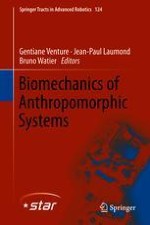We explore the conceptual design and implementation of muscle redundancy and kinematic redundancy for anthropomorphic robots from three perspectives: (i) The control of tendon-driven systems, (ii) How the number of muscles define functional capabilities, and (iii) How too few synergies can be detrimental to functional versatility. Historically, roboticists prefer either rotational actuators located at each joint (i.e., rotational degree-of-freedom, DOF), or few linear actuators (i.e., two dedicated muscles per joint) for tendon-driven robots. In contrast, biological limbs have evolved to include too many muscles (Valero-Cuevas in Fundamentals of neuromechanics. Springer, Berlin (2015) [
1]), which are thought to unnecessarily complicate their anatomy and control. The question, then, is why has evolution converged on these apparently under-determined (or redundant) solutions? If we really have extra muscles, then which muscle would you give up? By taking a formal mathematical approach to the control of tendons—which is the actual problem that confronts the nervous system—we have proposed a resolution to this apparent paradox by proposing that vertebrates may have, in fact, barely enough muscles to meet the numerous physical constraints for ecological functions (as opposed to simple laboratory tasks) (Valero-Cuevas in Fundamentals of neuromechanics. Springer, Berlin (2015) [
1]; Loeb in Overcomplete musculature or underspecified tasks? Mot Control 4(1):81–83 (2000) [
2]). This approach can be called Feasibility Theory, which describes how the anatomy of the system, and the constraints defining the task define the set of feasible actions the system can produce. The role of the (neural or engineered) controller is then, to find ways to use the mechanical capabilities of the combined controller-plant system to the fullest (Valero-Cuevas in Fundamentals of neuromechanics. Springer, Berlin (2015) [
1]. Similarly, the effective mechanical design of a robotic limb, at a minimum, requires controllability (i.e., enough control degrees of freedom, or muscles) to produce arbitrary forces and movements (i.e., changes of state; Ogata in Modern control engineering. Prentice hall, India (2002) [
3]). Force and movement capabilities have distinct governing equations and are, in fact, in competition with one another (e.g., a see-saw demonstrates, as per the Law of Conservation of Energy, how producing higher forces is associated with lower velocities and vice versa). Therefore, we explored the potential evolutionary pressures that may have shaped vertebrate limbs by evaluating how the number of muscles affects the competing demands to produce endpoint forces and velocities. A related concept that cuts across biological and robotic systems is the idea that the kinematics and kinetics of a wide variety of actions exhibit a low-dimensional structure that can be approximated with a few principal components (sometimes called descriptive synergies; Brock and Valero-Cuevas in Transferring synergies from neuroscience to robotics comment on hand synergies: integration of robotics and neuroscience for understanding the control of biological and artificial hands by M. Santello et al. Phys Life Rev 17:27 (2016) [
4]; Rieffel et al. in Automated discovery and optimization of large irregular tensegrity structures. Comput Struct 87(5):368–379 (2009) [
5]). This has been taken to mean that a few degrees of freedom suffice to produce versatile behavior in the real world. However, the fine behavioral details that distinguish different actions are, by definition, not captured by the commonalities among them. Thus, versatility in the real world likely depends on recognizing and executing fine distinctions among actions; which implies that more degrees of freedom of control are critical for true functional versatility. These three independent arguments support the perspective that creating anthropomorphic systems requires apparently redundant structures, because only then can they truly execute a wide variety of real-world tasks. In addition, we also present an open-access MATLAB toolbox that allows users from different backgrounds to explore these concepts in detail. We believe this new perspective will improve the conceptualization, understanding, and design of anthropomorphic systems.
